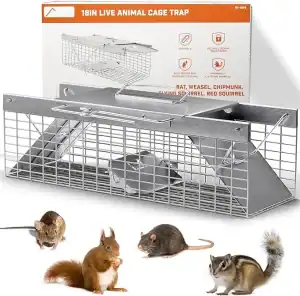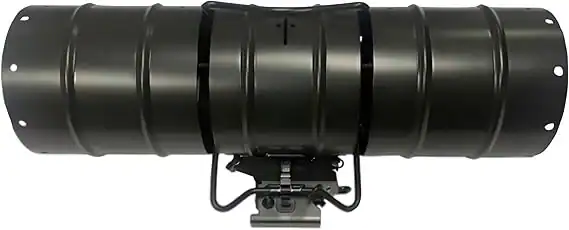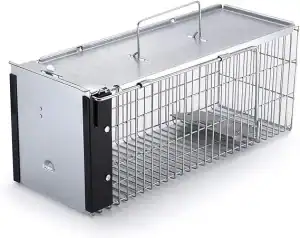Why Trap a Squirrel? Identifying Your Squirrel Problem
Squirrels can cause a range of issues, from chewing on wires to nesting in your attic. But before deciding to trap a squirrel, it’s crucial to understand the root cause of the problem. Is it the attic, garden, or perhaps the bird feeder that’s attracting these rodents?
Are They in Your Attic, Walls, or Garden?
If squirrels are in your attic, they may be nesting and reproducing, causing damage to insulation, wires, and even structural elements. In walls, they chew through materials, potentially creating fire hazards. For gardens, they can dig up plants or raid bird feeders. If squirrels are digging up your vegetable garden, DIY ways to keep squirrels out of your garden might be an excellent solution before turning to traps. If you still need to trap them, a squirrel trap might be your next step.
Squirrels at the Bird Feeder: When Deterrents Fail
Squirrels at the bird feeder are a common nuisance. Even the best squirrel-proof feeders often fail against these persistent creatures. When deterrents no longer work, it’s time to think about using a squirrel trap. Trapping squirrels might be the most effective solution, especially if they’re wreaking havoc on your bird station.
Identifying the Culprit: Ground Squirrels vs. Tree Squirrels (Grey, Red, Black)
Understanding which type of squirrel you’re dealing with is crucial in choosing the right squirrel traps. Ground squirrels often burrow into the soil, whereas tree squirrels, like grey, red, and black squirrels, are climbers. The type of squirrel will impact your trapping methods and the best bait for squirrel traps.
Before You Set a Trap: Is It Legal?
Before setting any squirrel trap, it’s essential to understand the legalities involved. In many places, trapping squirrels is regulated to prevent harm to local ecosystems.
Why Is It Illegal to Release a Trapped Squirrel in Many Areas?
In some states, it’s illegal to release a trapped squirrel because of concerns about disease transmission or disrupting local wildlife populations. Understanding local regulations is vital for responsible trapping.
Understanding Local Wildlife Laws: Relocation vs. Euthanasia
Laws vary by location, and in some cases, you may be required to euthanize a trapped squirrel. It’s important to familiarize yourself with local wildlife laws to ensure you’re complying with all regulations.
Humane Trapping: The Ethical Considerations
When using humane squirrel traps, it’s essential to consider the welfare of the animal. Ethical trapping methods prioritize the squirrel’s well-being and offer a non-lethal alternative for homeowners.
The 2 Main Types of Squirrel Traps: A Comparison
When it comes to trapping squirrels, there are two primary types of traps: live traps and lethal traps. Both have pros and cons, and your choice will depend on the type of situation you’re dealing with.
Live Squirrel Traps (Humane / Cage Traps)
Live traps are designed to capture squirrels without harming them. These are generally considered humane and safe for the animal.
Pros and Cons of Live Traps
Live traps are effective for capturing squirrels without causing harm. However, they require proper handling and may not be suitable for larger infestations. Popular live squirrel traps include Havahart squirrel traps, known for their reliability and effectiveness in safely trapping squirrels.
Lethal Squirrel Traps (Kill Traps)
In contrast, lethal traps are designed to kill the squirrel immediately upon capture. These traps are often quicker but may not be the most humane option for those seeking non-lethal solutions.
Pros and Cons of Kill Traps
While lethal traps like snap traps and conibear traps offer fast solutions, they can be controversial due to their impact on the squirrel. Some prefer the quick and efficient action of these traps but may feel discomfort with their methods.
Types: Snap Traps, Conibear, and Instant Kill Squirrel Traps
Different kill traps exist, with instant kill squirrel traps being among the most efficient for quick results. However, they may not be ideal for all scenarios, especially in urban or residential areas.
A Note on Glue Traps: Why You Should Never Use Them
Although glue traps are sometimes marketed for small animals, they are an inhumane way to trap squirrels. These traps often cause severe distress and suffering for the animal, and should never be used.
What is the Best Bait for a Squirrel Trap?
When it comes to trapping squirrels, selecting the right bait is crucial. The wrong bait can cause squirrels to avoid the trap entirely, while the right bait ensures they can’t resist.
The Top 5 Best Baits for Squirrel Traps (Peanut Butter, Nuts, Seeds)
Squirrels are naturally attracted to foods high in fat and protein. The best options for baiting a squirrel trap include:
- Peanut Butter – A top choice for its strong scent and consistency.
- Nuts – Particularly hazelnuts, walnuts, and almonds.
- Seeds – Sunflower or pumpkin seeds are ideal.
- Fruit – Apples, bananas, and grapes work well, especially for tree squirrels.
- Cheese – A favorite for squirrels, although it may not be as effective as nuts or peanut butter.
Good Squirrel Bait for Traps vs. Bad Bait (What to Avoid)
While some foods might attract squirrels, others may not. Avoid using overly sweet or processed foods like candy, as squirrels are less likely to find them appealing. Also, refrain from using meats or heavily salted items.
How to Bait a Squirrel Trap Effectively (Placement is Key)
Proper bait placement is crucial for trapping squirrels. Place the bait at the far end of the trap, encouraging the squirrel to step inside completely. You can also smear some peanut butter on the trap’s trigger mechanism to increase its effectiveness. Always use a small amount—enough to attract them, but not so much that it overpowers the scent.
How to Trap a Squirrel: A Step-by-Step Guide
Now that you’ve selected your trap and bait, it’s time to get to work. Trapping squirrels involves a few key steps to ensure the process goes smoothly.
How to Set a Squirrel Trap (Live Cage Trap)
To set a live squirrel trap:
- Open the trap and place it on a flat surface where squirrels frequent.
- Secure the bait inside the trap, ensuring it’s positioned far enough back so the squirrel must enter fully.
- Set the trap’s door mechanism to trigger when the squirrel steps inside.
- Check the trap regularly to ensure the squirrel doesn’t stay trapped for too long.
How to Set a Squirrel Kill Trap Safely
For lethal traps, setting them requires careful handling to ensure you don’t accidentally harm yourself or other wildlife:
- Place the trap in areas where squirrels are known to frequent, such as near their nest or along their travel paths.
- Position the trap’s trigger mechanism so it will activate once the squirrel steps inside.
- Make sure to check the trap regularly to avoid an animal suffering for too long.
Where to Place Your Trap for Maximum Success (Runways, Entrances)
For the best chance of success, place your trap near areas squirrels frequently visit. Squirrel traps for attic should be positioned near their entry points. For ground squirrels, look for signs of burrows or nests to place the trap. Ideally, place the trap along established runways or near food sources to lure them in.
Problem-Specific Trapping Strategies
Different environments require different strategies. Here’s how to approach specific squirrel problems.
How to Trap Squirrels in the Attic (Using a One-Way Door & Trap)
Trapping squirrels in your attic can be tricky, as you’ll need to catch them without allowing more in. One method is using a one-way squirrel trap door to let the squirrels out but not back in. Once they’re outside, set your trap nearby to capture them when they return. Understanding where do squirrels sleep and build their “dreys” is essential for finding their main travel paths inside your home.
How to Trap a Squirrel in Your House
If a squirrel has made its way into your home, place the trap in areas where it frequently travels, such as in hallways, near windows, or along the baseboards. You can also use bait like peanut butter near its entry point to lure it into the trap.
How to Trap Ground Squirrels (Tube Traps & Bait Stations)
Ground squirrels require specific traps. Tube traps are especially effective for them as they mimic their natural burrowing instincts. Place the tube trap near burrows or food sources, and use a ground squirrel trap bait station to entice them further into the trap.
Trapping Different Species: Red Squirrels, Flying Squirrels, and Chipmunks
Different types of squirrels require different traps. For example, red squirrels are more aggressive and may require larger traps, while flying squirrels may need traps that accommodate their unique movement patterns. Chipmunks can also be trapped with smaller versions of the standard live squirrel traps.
You’ve Trapped a Squirrel… Now What?
After successfully trapping a squirrel, it’s important to handle the situation with care. Whether you plan to release or humanely euthanize the squirrel, follow these steps to ensure safety and compliance with the law.
How to Safely Handle a Live Squirrel Trap
When handling a live squirrel trap, wear gloves to protect yourself from bites or scratches. Always approach the trap slowly and carefully to avoid startling the animal. If you need to release the squirrel, ensure it is done in a legal and humane way.
Releasing a Trapped Squirrel (If Legal)
If releasing the squirrel is legal in your area, choose a remote location far from your home, such as a wooded area or park. Ensure you’re complying with local laws before releasing the animal.
How to Humanely Euthanize a Trapped Squirrel (If Required by Law)
If euthanizing a squirrel is required by law, do so humanely. You can contact local animal control or a wildlife rehabilitation center for guidance. Some traps are designed to kill the squirrel instantly to avoid unnecessary suffering.
Cleaning and Disposing of Traps
After trapping and releasing or euthanizing a squirrel, clean the trap thoroughly with soap and water to remove any scents that might attract future squirrels. Dispose of the squirrel and any waste properly to avoid attracting other pests.
The Best Squirrel Traps of 2025: Reviews
With a variety of traps available, choosing the best squirrel trap can be challenging. Below, we review some of the top options for both live and lethal trapping.
Best Live Trap: Havahart Squirrel Trap (Models & Sizes)
Havahart squirrel traps are widely regarded as some of the best live traps on the market. Known for their effectiveness, these traps come in various models and sizes, designed to safely capture squirrels without harm. Whether you’re dealing with a small infestation or need something larger, Havahart squirrel traps provide a reliable solution. The traps are easy to set up, humane, and reusable.

Best Lethal Trap: The A18 Squirrel Trap and Tube Traps
If you’re looking for a quick solution, lethal traps might be the best choice. The A18 squirrel trap is a popular option for its instant killing mechanism. Tube traps are also effective, particularly for ground squirrels, as they mimic their natural burrowing habits. These traps offer efficiency but should be used with consideration for animal welfare and legalities in your area.

The Squirrelinator: A Good Repeater Trap?
For those who have persistent squirrel issues, the Squirrelinator is a trap that allows for multiple captures without resetting. This live squirrel trap is a repeater, designed to trap multiple squirrels at once. It’s ideal for larger infestations where one capture won’t solve the problem. Its effectiveness makes it a favorite among homeowners dealing with a recurring squirrel proble

Can You Use a Rat Trap for Squirrels? (Covers “Squirrel Rat Trap”)
While some people may consider using a squirrel rat trap, these traps are not designed for squirrels and can often lead to ineffective results or inhumane treatment. Squirrel traps are larger and more specifically designed to accommodate their size and behavior. Rat traps are typically too small, making them unsuitable for squirrels.
DIY Squirrel Traps: How to Make Your Own
For those who want to take a more hands-on approach, building a DIY squirrel trap can be a cost-effective and satisfying solution. Here are some basic DIY trap ideas:
How to Make a Homemade Squirrel Trap (Simple Box Trap)
A simple box trap is easy to construct and can be quite effective. You’ll need basic materials such as wood, wire mesh, and a spring mechanism for the trap door. Once assembled, place bait inside, and wait for the squirrel to enter. This basic design can be customized to suit different types of squirrels.
How to Build a DIY Squirrel Bucket Trap
A DIY squirrel bucket trap is another popular option. To make this trap, you’ll need a bucket, a PVC pipe, and bait. The pipe is placed on the rim of the bucket, allowing squirrels to fall inside when they try to reach the bait. This method is effective and cheap, though it may require monitoring to ensure the squirrels are handled humanely.
Where to Buy Squirrel Traps
Finding the right place to purchase your squirrel trap is essential for convenience and cost-effectiveness. Here are some popular options for purchasing traps.
Squirrel Traps at Home Depot, Lowe’s, and Tractor Supply
For those who prefer to shop in-store, Home Depot, Lowe’s, and Tractor Supply are excellent options for purchasing both live and lethal squirrel traps. These stores carry a variety of brands, including well-known options like Havahart and other reputable squirrel trap manufacturers. Check your local store for availability.
Buying Squirrel Traps Online
If you’re looking for convenience, buying online may be your best option. Amazon offers a wide selection of squirrel traps, including customer reviews to help you make an informed decision. Whether you’re interested in live squirrel traps or lethal options, Amazon’s range ensures that you’ll find the best trap for your needs.
Finding “Squirrel Traps Near Me” (Local Hardware & Feed Stores)
If you’d rather support local businesses, searching for squirrel traps near me can lead you to nearby hardware or feed stores that carry a selection of traps. Often, these stores will have knowledgeable staff who can recommend the best option for your specific squirrel problem.
Frequently Asked Questions
Squirrels trapped in walls can survive for several days, but their chances of survival decline if they have no access to food or water. It’s critical to remove trapped squirrels as soon as possible to avoid suffering. For tips on trapping squirrels in hard-to-reach places, refer to our guide on how to trap squirrels in walls.
The best humane squirrel trap is a live cage trap, such as Havahart squirrel traps. These traps allow you to capture squirrels safely without harming them, ensuring that they can be released elsewhere in accordance with local laws.
For those who need a lethal solution, the A18 squirrel trap is an excellent choice. It offers a quick, humane kill when set up properly. However, always check your local wildlife laws to ensure that using such a trap is permitted in your area.
Yes, many live squirrel traps can also be used to trap chipmunks. Since both animals are similar in size, a standard live trap designed for squirrels will typically work for chipmunks as well. However, you might need a smaller trap for chipmunks if the squirrels are larger.









